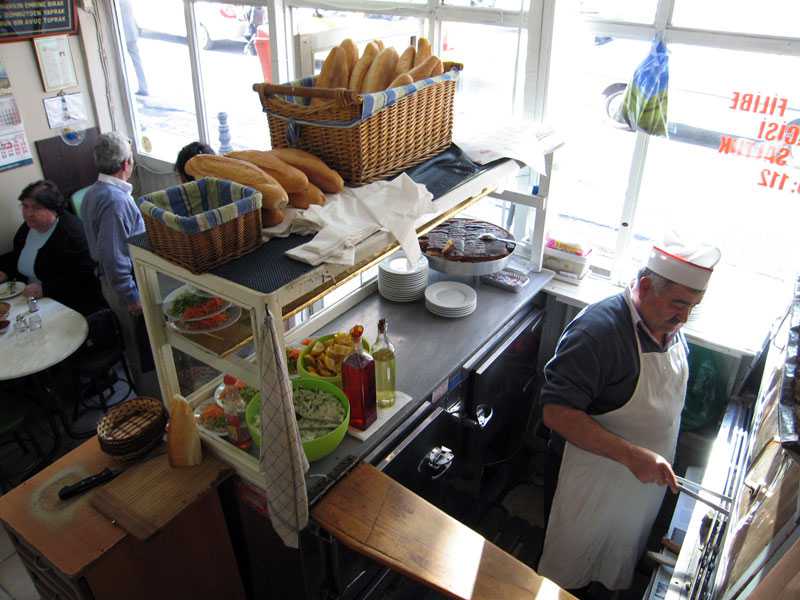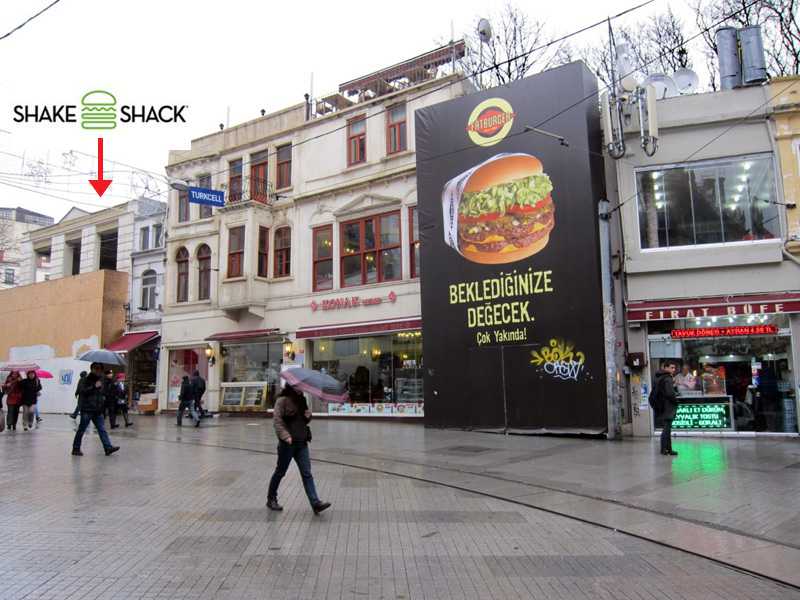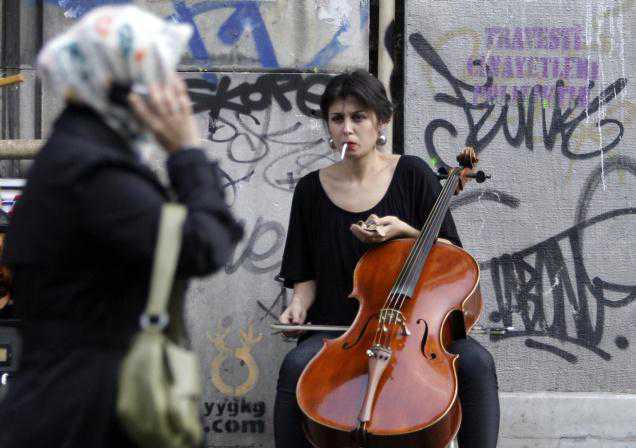Turkish cuisine, like Turkey itself, channels cultural currents coming in from every direction, resulting in the delicious culinary chaos that is Istanbul. Turks, Greeks, Arabs, Persians and countless others have passed through here, leaving an indelible stamp on the cuisine. Historians speak of the “layered” nature of the city; we like to think of Istanbul as a stew.
Our culinary walks in Istanbul, done in partnership with the award-winning IstanbulEats.com, are designed to lead visitors on an eating binge through the city’s lesser-seen historic side streets and authentic markets, taking in countless hard-to-find culinary gems and, in between bites, a select number of untouristed monuments.
We are currently happy to offer four walks:
Cosmopolitan Beyoğlu
Until recently, Greek, Armenian and Ladino (Judeo-Spanish) were the languages spoken in most kitchens of Istanbul’s historic district of Beyoğlu. Though the old cosmopolitans who populated the belle époque apartment buildings of Istanbul’s “European Quarter” have largely been replaced by a vibrant blend of rural Anatolians and global bohemians, traces of these unique cultures remain, creating a very unique dining culture – at once rough and refined. With Beyoğlu’s cosmopolitan history as a backdrop, on this walk we eat our way through the well-known and unknown eateries of the neighborhood, the old and the new, tasting specialties from all over the country. Beginning with a fresh simit and tea and a crash course in Anatolian cheeses, we’ll have a bracing shot of pickle juice and maybe a chicken breast pudding for starters. Winding our way through the side streets, there will be Chechen pastries, sublime Turkish delight, fish markets, street vendors, a full lunch and finally, the best Turkish coffee in the city. Depending on the day and what the walk comes across, there will be several other culinary surprises along the way.
Culinary Secrets of the Old City
Our “Culinary Secrets of the Old City” walk takes you beyond the major monuments and into the backstreets where all of the serious eating is done. We set off through the atmospheric, lesser-explored market streets around the Egyptian Spice Market and deeper into the untouristed Fatih neighborhood. In Kantarcılar, a district that has been selling weights and measures since Ottoman times, we visit a local confectionary where Turkish delight has been made and sold for four generations. From there we visit an all-but-abandoned caravanserai, a couple of hidden historical sites, an old-school pudding shop, an Ottoman-era bozacı and, finally, a full lunch of traditional pit-roasted lamb in a very local, family-run place next to the Byzantine aqueduct (with lots of other edible treats along the way). These are the city’s quintessential culinary backstreets.
Two Markets, Two Continents
Our favorite Istanbul experiences include exploring the eateries of local markets and crossing the Bosphorus on the public ferry. The “Two Markets, Two Continents” route draws from our best-of list in the European side’s Karaköy neighborhood and the Asian side’s Kadıköy, tied together by a Bosphorus crossing. The historic Perşembe Pazarı of Karaköy, where this walks begins, might look like a place to buy springs, ship anchors, hardware and paint supplies, but we go there for breakfast at a lovely little esnaf lokantası run by husband-and-wife team, followed by a stroll through the atmospheric mariner market streets, where we stop into an Ottoman-era caravanserai for tea. Then we hop the boat to Kadıköy on the Asian side and eat our way through that neighborhood’s market, sampling regional specialties such as Mersin’s tantuni, Gaziantep’s lahmacun and the ıslama köfte of Adapazarı. We continue on toward the lesser-explored culinary hotspot of Moda, where we will taste life-changing traditional desserts from Turkey’s Southeast and Black Sea regions and, to round things out, visit a neighborhood institution for authentic Turkish ice cream.
The Kebab Krawl
It’s nighttime in Istanbul’s “Little Urfa.” Follow the wail of the Kurdish Frank Sinatra, İbrahim Tatlıses, blasting from a souped-up vintage Fiat. Puzzle over handwritten Arabic signs in the barbershop windows. Sample the essence of Southeast Turkey in the spice shops selling the region’s fiery peppers. And, most of all, marinate in the fragrant smoke that comes from the countless grill houses that line this neighborhood’s streets. These are among the sights, sounds, smells and – most importantly – tastes that are part of an unforgettable guided group dinner in the culinary backstreets of Little Urfa. Led by members of the Istanbul Eats team, the Kebab Krawl is a carefully curated nighttime feast of traditional Southeastern Turkish cuisine that changes locations with every course, allowing you to take in the best of this atmospheric out-of-the-way ’hood. The Krawl will begin with the gumbo-like masterpiece soup, beyran çorbası, and then detour for skewered liver from a fourth-generation Urfa griller. There will be a stop at a bakery for artisanal lahmacun straight out of the oven and then we’ll belly up to the kebab bar of Veysel Usta, for his exceptionally delicious handmade kebabs, served up with sharp wit. We will not relent until the group has made one more stop, for the neighborhood’s best künefe, a funky pastry of fresh cheese and crispy shredded wheat spiked with Anteppistachios. As it rolls along, the Kebab Krawl will also make stops at other local food and spice shops for a further taste of local flavor. Less a tour than an organized movable feast for the hungry and intrepid, the Kebab Krawl may not replace a bus ticket to Urfa, but it is the next best thing.
All four walks are designed for small groups and usually last half a day (except for the Kebab Krawl, which takes place at night and lasts several hours). Please contact us at [email protected] for more details and rates.
Our Istanbul Walks in the Press:
The Washington Post
Serious Eats
The Atlantic
PRI’s The World
Dinner Party Downloads
Below are some comments that we’ve received from visitors to Istanbul who have taken our walks:
“Our Istanbul Eats culinary walk was one of the highlights of our trip to Istanbul. We enjoyed every second of it. Angelis, our guide, was extremely knowledgeable and a perfect host. Not only did he introduce us to some unique food and interesting little restaurants, he also took us to a few historical sites that were off the beaten path. The only problem with our walk was I wish our appetites were larger so we could have had more! It was definitely a perfect combination of one-of-a-kind food in a one-of-a-kind setting and we would recommend it to anyone who is visiting Istanbul and wants a better understanding of the food and to visit some non-touristy places.”
Mindy and Brock
Toronto, Canada
“The Istanbul Eats walk was definitely one of the highlights on our recent trip to Turkey. We spent almost five hours exploring the places where locals shop and eat. Having never been to Istanbul, we would have gone to the usual touristy spots, and probably eaten well, but never have found the tasty delights that the walk introduced us to. But it wasn’t just about the food. We saw parts of the city that we might never have seen… back streets and old buildings, traditional shops and family businesses that have been producing amazing foods generation after generation, the kind of places that are disappearing all too fast as the city modernizes.”
Liz and Teymoor, Qatar
“The Istanbul Eats walking tour was a great, non-touristy experience — like going out with a local friend who knew all the off-the-beaten-path great authentic markets, shops and eateries we would never have found on our own. To cap it off, we were given restaurant suggestions that were spot on, which made the rest of our week a pleasure. What a way to sample the fabulous foods of Istanbul!”
Ken Kopelman, NYC
“If you want an authentic taste of the Old City area surrounding the Spice Market, put away your guidebooks and go on an insider’s tour that takes you through the ‘rarely seen’ secret places and sites on the culinary walk provided by Istanbul Eats. You will be welcomed into generations-old tea rooms, food merchants’ kitchens and shops, working peoples’ restaurants, hidden mosques and the most intriguing landmarks and curious sights that you won’t find on those tours where the guide rallies a mob of people around an upheld umbrella. At the end of this tour your stomach is full and your expectations have been fulfilled. Walk. Eat. Marvel!”
Lew Sherwood, USA
“El tour es espectacular, me llevaron a lugares que son muy dificiles de encontrar por tu cuenta. Terminamos comiendo sandia, queso y pan ( ¡! ) con unos parroquianos en un cafe inencontrable. La gente es muy amable en Turquia. Recomiendo hacer la caminata los primeros dias al llegar a Estambul, asi despues puede uno moverse con mas soltura dentro del alucinante mundo gastronomico que tiene Estambul. No dejen de probar el Kokorec, una especie de choto Uruguayo superdimensionado.”
Estanislao, Spain
 But don’t tell that to Ziver Usta, who’s been turning the köfte – something like Turkey’s equivalent of the hamburger – at the grill of the shoe-box-sized Meşhur Filibe Köftecisi in Sirkeci for the last 30 years. The dough-faced Ziver, in his early fifties, is actually the restaurant’s junior employee – “head waiter” Mehmet has been there for 40 years – but his long tenure means he’s only one of a select handful of grill masters who have worked at Filibe over the course of its 100-year history.
But don’t tell that to Ziver Usta, who’s been turning the köfte – something like Turkey’s equivalent of the hamburger – at the grill of the shoe-box-sized Meşhur Filibe Köftecisi in Sirkeci for the last 30 years. The dough-faced Ziver, in his early fifties, is actually the restaurant’s junior employee – “head waiter” Mehmet has been there for 40 years – but his long tenure means he’s only one of a select handful of grill masters who have worked at Filibe over the course of its 100-year history.




